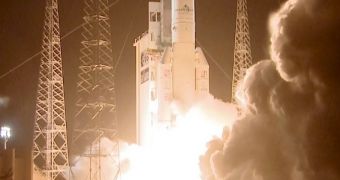On Saturday, March 22, an Ariane V heavy-lift delivery system completed this rocket series' second successful flight of 2014. The Ariane V VA216 launched from the Kourou Spaceport in French Guiana, South America, at 2204 GMT (19:04 local time), boosting two telecommunications satellites into their planned transfer orbits.
The spacecraft, Astra-5B and Amazonas-4A, were inserted into a geostationary transfer orbit (GTO) with a perigee of 250 kilometers (155 miles) and an apogee of 35,736 kilometers (22,205 miles). Inclination level was just 3 degrees with respect to Earth's equator, officials at the European Space Agency (ESA) announced on Saturday, shortly after launch.
Astra-5B is owned and operated by SES in Luxembourg, while Amazonas-4A is owned by Hispasat, in Spain. The former boasts a launch mass of 5,755 kilograms (12,690 pounds), while the latter is much lighter, at just 2,938 kilograms (6,477 pounds). The burns required for the Ariane V to properly insert the two spacecraft into their orbits were entirely controlled by the rocket's onboard computers.
Both satellites are scheduled to remain in orbit for at least 15 years, providing services including direct-to-home television broadcast, digital terrestrial television network services cable distribution, and other telecommunications services for areas in South America and Europe. Thus far, out of 73 launches for the Ariane V rocket, 69 have been successful and 2 ended in only partial failures.

 14 DAY TRIAL //
14 DAY TRIAL //